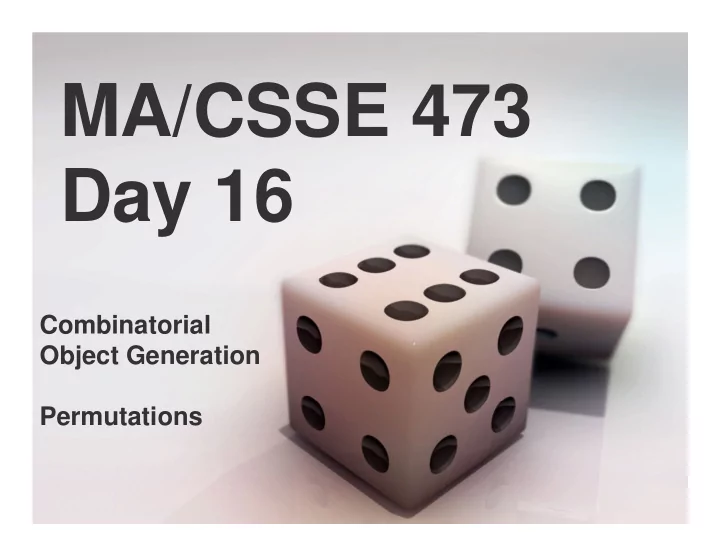

MA/CSSE 473 Day 16 Combinatorial Object Generation Permutations
MA/CSSE 473 Day 16 • No new announcements • Student Questions • Combinatorial Object Generation – Intro • Permutation generation Q1
Permutations Subsets COMBINATORIAL OBJECT GENERATION
Combinatorial Object Generation • Generation of permutations, combinations, subsets. • This is a big topic in CS • We will just scratch the surface of this subject. – Permutations of a list of elements (no duplicates) – Subsets of a set
Permutations • We generate all permutations of the numbers 1..n. – Permutations of any other collection of n distinct objects can be obtained from these by a simple mapping. • How would a "decrease by 1" approach work? – Find all permutations of 1.. n-1 – Insert n into each position of each such permutation – We'd like to do it in a way that minimizes the change from one permutation to the next. – It turns out we can do it so that we always get the next permutation by swapping two adjacent elements.
First approach we might think of • for each permutation of 1..n-1 – for i=0..n-1 • insert n in position i • That is, we do the insertion of n into each smaller permutation from left to right each time • However, to get "minimal change", we alternate: – Insert n L-to-R in one permutation of 1..n-1 – Insert n R-to-L in the next permutation of 1..n-1 – Etc.
Example • Bottom-up generation of permutations of 123 • Note the error in this figure in the Levitin book • Example: Do the first few permutations for n=4
Johnson-Trotter Approach • integrates the insertion of n with the generation of permutations of 1..n-1 • Does it by keeping track of which direction each number is currently moving → ← → ← 3 2 4 1 The number k is mobile if its arrow points to an adjacent element that is smaller than itself • In this example, 4 and 3 are mobile
Johnson-Trotter Approach → ← → ← 3 2 4 1 • The number k is mobile if its arrow points to an adjacent element that is smaller than itself. • In this example, 4 and 3 are mobile • To get the next permutation, exchange the largest mobile number (call it k) with its neighbor • Then reverse directions of all numbers that are larger than k. • Initialize: All arrows point left
Johnson-Trotter Driver
Johnson-Trotter background code
Johnson-Trotter major methods
Lexicographic Permutation Generation • Generate the permutations of 1..n in "natural" order. • Let's do it recursively.
Lexicographic Permutation Code
Permutations and order • Given a permutation number permutation number permutation 0 0123 12 2013 of 0, 1, …, n-1, can 1 0132 13 2031 we directly find the 2 0213 14 2103 next permutation in 3 0231 15 2130 the lexicographic 4 0312 16 2301 sequence? 5 0321 17 2310 6 1023 18 3012 • Given a permutation 7 1032 19 3021 of 0..n-1, can we 8 1203 20 3102 determine its 9 1230 21 3120 10 1302 22 3201 permutation 11 1320 23 3210 sequence number? • Given n and i, can we directly generate the i th permutation of 0, …, n-1?
Recommend
More recommend